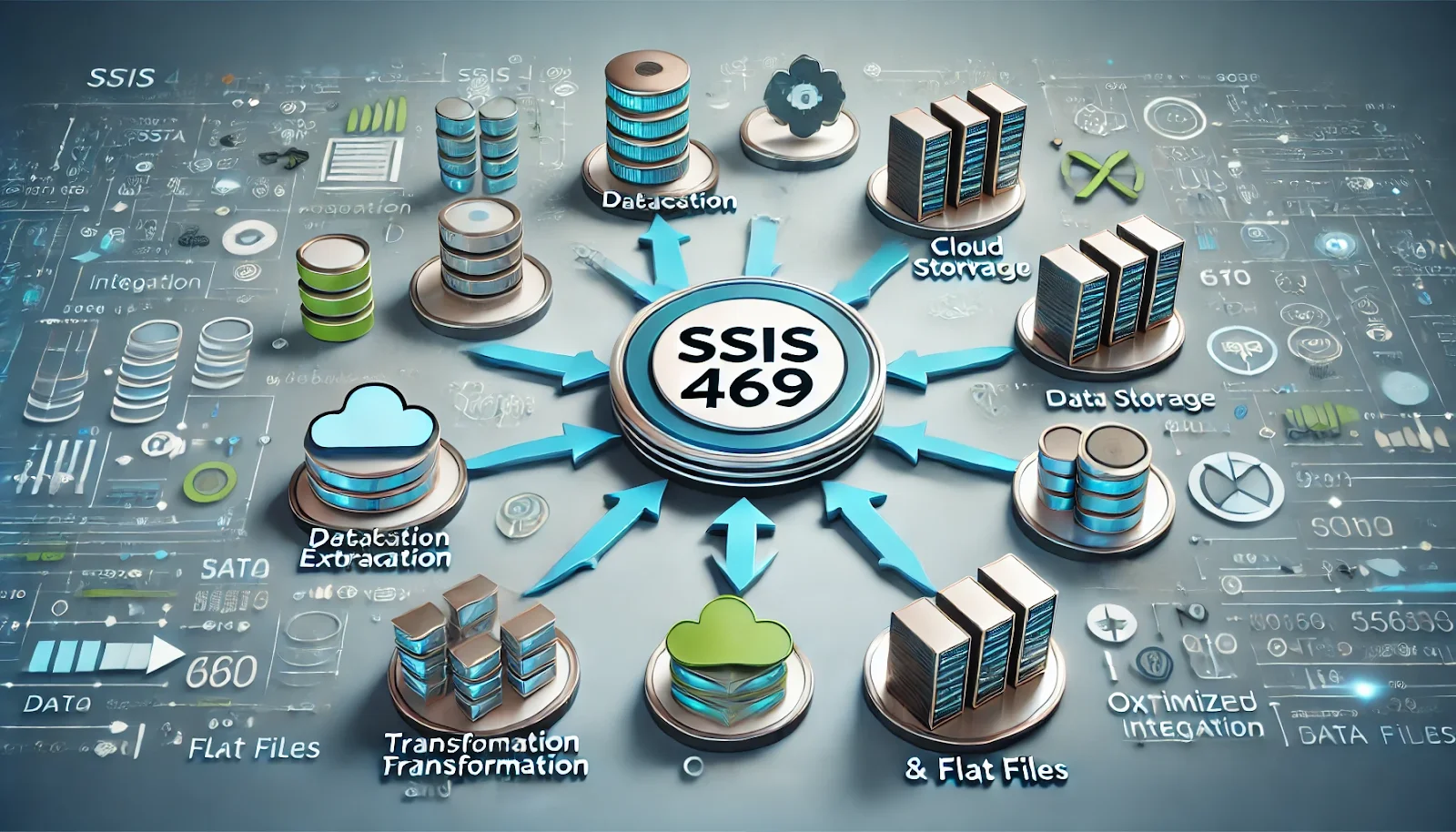Tech
SSIS 469: Revolutionizing Data Integration & ETL

In the ever-evolving landscape of data management, SSIS 469 organizations are continually seeking efficient solutions for data integration and extraction, transformation, and loading (ETL). SQL Server Integration Services (SSIS) has long been a cornerstone of Microsoft’s data management suite, and with the advent of SSIS 469, it promises to further revolutionize the way businesses handle their data workflows. This article delves into the features, enhancements, and overall impact of SSIS 469 on the ETL process.
What is SSIS?
SQL Server Integration Services is a platform for building high-performance data integration and workflow applications. It enables users to perform data extraction, transformation, and loading from various sources to destinations. SSIS has traditionally been favored for its robust capabilities, ease of use, and seamless integration with other Microsoft products.
Key Features of SSIS 469
1. Enhanced Performance
One of the most significant improvements in SSIS 469 is the optimization of data processing speed. Leveraging advancements in parallel processing and improved memory management, SSIS 469 allows for quicker data transformations and more efficient resource usage. This enhancement is crucial for organizations dealing with large datasets, enabling them to reduce load times and improve overall performance.
2. User-Friendly Interface
SSIS 469 introduces a more intuitive user interface, making it easier for both seasoned data professionals and newcomers to navigate the platform. The new design focuses on user experience, streamlining the creation and management of ETL packages. Features like drag-and-drop functionality and customizable dashboards simplify complex tasks, allowing users to visualize their workflows better.
3. Advanced Data Connectivity
With an ever-growing number of data sources, SSIS 469 expands its connectivity options significantly. It now supports more third-party connectors and native support for cloud platforms such as Azure and AWS. This advancement ensures that organizations can easily integrate data from diverse environments, whether on-premises or in the cloud, enhancing flexibility and scalability.
4. Integration with Machine Learning
As data analytics becomes increasingly intertwined with machine learning, SSIS 469 provides built-in capabilities for integrating machine learning models into ETL processes. Users can now invoke machine learning algorithms during data transformation, allowing for advanced data cleansing and enrichment strategies that enhance decision-making processes.
5. Improved Monitoring and Troubleshooting
Monitoring data workflows has always been a challenge in ETL processes. SSIS 469 introduces enhanced logging and monitoring features, providing real-time insights into package execution. This improvement enables users to identify bottlenecks and troubleshoot issues more effectively, ultimately leading to smoother operations and reduced downtime.
6. Enhanced Security Features
Data security remains a top priority for organizations handling sensitive information. SSIS 469 strengthens security protocols, offering advanced encryption methods and more granular access controls. This ensures that data is protected at every stage of the ETL process, addressing compliance requirements and safeguarding against data breaches.
Impact on Data Integration and ETL
The enhancements brought by SSIS 469 have far-reaching implications for organizations engaged in data integration and ETL. By streamlining processes, improving performance, and enhancing connectivity, businesses can achieve more efficient data management practices. This efficiency not only saves time and resources but also enables organizations to harness data more effectively for strategic decision-making.
Furthermore, the integration of machine learning capabilities into ETL processes signifies a shift towards more intelligent data management. Organizations can now automate data enrichment and cleansing, allowing for higher quality data analytics and insights.
Conclusion
SSIS 469 represents a significant leap forward in the realm of data integration and ETL. With its enhanced performance, user-friendly interface, advanced connectivity, and focus on security, it empowers organizations to transform their data workflows. As businesses continue to navigate the complexities of data management, SSIS 469 stands out as a powerful tool in the arsenal of data professionals, revolutionizing how data is integrated, processed, and utilized across industries. Embracing SSIS 469 is not just about adopting a new tool; it’s about unlocking the full potential of data to drive business success in a data-driven world.
FAQS
Q1: What is SSIS 469?
A1: SSIS 469 refers to the latest version of SQL Server Integration Services (SSIS), a platform for building high-performance data integration and ETL (Extract, Transform, Load) solutions. It focuses on enhancing data workflows and streamlining data management processes.
Q2: How does SSIS 469 differ from previous versions?
A2: SSIS 469 introduces advanced features such as improved data connectors, enhanced performance tuning options, better support for cloud data sources, and a more user-friendly interface, making it easier to design and manage ETL workflows.
Q3: What are the key features of SSIS 469?
A3: Key features include
- Enhanced integration with Azure and other cloud services
- Support for real-time data processing
- Improved monitoring and debugging tools
- New data flow components
- Upgraded performance optimization tools
Q4: Who can benefit from using SSIS 469?
A4: SSIS 469 is beneficial for data engineers, business intelligence professionals, and organizations looking to streamline their data integration processes. It’s ideal for businesses that need to handle large volumes of data efficiently.
Q5: What types of data sources can SSIS 469 connect to?
A5: SSIS 469 supports a wide range of data sources, including relational databases (SQL Server, Oracle), cloud storage (Azure Blob, AWS S3), flat files, XML, and more, making it versatile for various data integration tasks.
Q6: Is SSIS 469 suitable for real-time data integration?
A6: Yes, SSIS 469 supports real-time data integration through features that enable the capture and processing of streaming data, allowing organizations to make timely decisions based on up-to-date information.
Q7: How can I get started with SSIS 469?
A7: To get started, you can download the latest version of SQL Server that includes SSIS, explore online documentation and tutorials, and consider taking training courses to familiarize yourself with its functionalities.
Q8: What are the system requirements for SSIS 469?
A8: SSIS 469 requires a compatible version of SQL Server, sufficient RAM (at least 4 GB recommended), and a modern operating system (Windows 10 or later). Specific requirements can vary based on your deployment and usage.
Q9: Can SSIS 469 integrate with other Microsoft tools?
A9: Yes, SSIS 469 integrates seamlessly with other Microsoft tools, such as Power BI for data visualization, Azure Data Factory for advanced data orchestration, and SQL Server Reporting Services (SSRS) for reporting.
Q10: Where can I find support or resources for SSIS 469?
A10: Support and resources can be found on the official Microsoft documentation site, community forums, and various online learning platforms that offer courses on SSIS and data integration techniques.
Tech
UVLACK: Redefining Innovation in the Digital Age

In today’s fast‑paced technological landscape, UVLACK emerging platforms and products often shape the way we connect, create, and consume content. One such rising name making waves across industries is UVLACK. Though still relatively new to the mainstream, UVLACK is steadily gaining recognition for its unique approach to digital solutions, user experience, and future‑ready innovation.
What Is UVLACK?
UVLACK is a forward‑thinking brand and platform dedicated to bridging gaps in digital communication and creative technology. At its core, UVLACK functions as a multi‑purpose ecosystem—offering tools and services that cater to professionals, creators, and businesses seeking smarter ways to operate in the modern digital world.
While its origins remain rooted in tech innovation, UVLACK’s vision has expanded. Today, it is known not only for its software capabilities but also for fostering an environment where collaboration and bold ideas thrive.
Key Features and Offerings
1. A Versatile Creative Suite
UVLACK’s flagship offering is its creative suite—a set of intuitive tools designed for graphic designers, content creators, and digital marketers. From advanced design templates to AI‑powered editing features, UVLACK ensures that even beginners can produce professional‑grade visuals in less time.
2. Collaboration at Its Core
The platform incorporates real‑time collaboration features, allowing teams scattered across the globe to brainstorm, design, and deploy projects seamlessly. Integrated chat, file sharing, and version control make UVLACK a central hub for remote teams.
3. Smart Analytics and Insights
Businesses benefit from UVLACK’s built‑in analytics dashboards. These provide real‑time insights into campaign performance, user engagement, and creative output—helping brands make data‑driven decisions with ease.
4. Cross‑Platform Accessibility
Whether you’re working on a desktop, tablet, or smartphone, UVLACK adapts to your workflow. Its cross‑platform compatibility ensures that you can create, edit, and share wherever you are.
Why Is UVLACK Gaining Attention?
UVLACK stands out because it blends ease of use with cutting‑edge technology. Unlike many complex software ecosystems, UVLACK prioritizes a clean interface and a user‑first approach.
- For creators, it means faster output without compromising quality.
- For businesses, it means a reliable platform that grows with their needs.
- For tech enthusiasts, it represents a bold step into the future of digital tools.
The Future of UVLACK
The roadmap for UVLACK suggests a steady expansion into AI‑driven automation, augmented reality integrations, and deeper customization for enterprise solutions. As more users adopt the platform, expect to see UVLACK partnering with brands, integrating with other popular tools, and becoming a go‑to solution in creative and digital workflows.
In conclusion, UVLACK is more than just a tool—it’s a movement toward smarter, faster, and more collaborative digital creation. For anyone looking to stay ahead in the rapidly evolving tech space, UVLACK is a name worth exploring.
Tech
Kalidcan: Unlocking the Potential of Next-Generation Digital Innovation

In today’s fast-paced digital world,Kalidcan innovation is key to staying ahead. Among the many emerging platforms and technologies shaping the future, Kalidcan is making waves as a cutting-edge digital concept that’s redefining user interaction, data integration, and smart system design. Whether it’s powering intelligent applications or streamlining enterprise solutions, Kalidcan is positioning itself as a name to watch in the realm of digital transformation.
What Is Kalidcan?
Kalidcan is a multifaceted digital platform or concept that blends modern technological tools—such as artificial intelligence (AI), data analytics, cloud infrastructure, and automation—into a unified ecosystem. While still under the radar in some circles, Kalidcan is gaining traction for its adaptability, innovation, and forward-thinking design principles.
Though the exact nature of Kalidcan varies depending on the context in which it’s applied (it may refer to a software product, a digital framework, or even a development model), it typically embodies:
- Smart automation
- Real-time data management
- User-centric design
- Scalable architecture
- Interoperability with other digital tools
Key Features of Kalidcan
- AI-Powered Intelligence
- Kalidcan harnesses artificial intelligence to provide smart recommendations, predict user behavior, and optimize system performance across various platforms.
- Cloud Integration
- Designed for scalability, Kalidcan seamlessly integrates with cloud-based systems, allowing users to manage data and services remotely and efficiently.
- Modular System Architecture
- Its modular approach means users can tailor Kalidcan to their specific needs, adding or removing functionalities as required.
- Security and Compliance
- Security is a core component of Kalidcan, offering built-in encryption, user authentication, and regulatory compliance features.
- Real-Time Insights
- With powerful analytics and dashboards, Kalidcan delivers real-time visibility into operations, customer behavior, or any domain it’s applied to.
Use Cases of Kalidcan
1. Business Automation
- Streamlining workflows and reducing operational costs with intelligent process automation.
2. Smart Applications
- Building AI-enhanced apps for finance, health, logistics, and education using Kalidcan’s robust API infrastructure.
3. Data Integration
- Unifying disparate data sources into a cohesive, actionable format for analytics and reporting.
4. Digital Marketing
- Enhancing customer targeting, lead generation, and campaign optimization with machine learning capabilities.
Why Kalidcan Stands Out
- Flexibility: Its adaptive framework supports both small startups and large enterprises.
- Innovation: Constant updates and community-driven development keep Kalidcan at the forefront of digital trends.
- User Experience: Emphasis on intuitive design ensures ease of use for both developers and end-users.
The Future of Kalidcan
As more organizations and developers seek unified, intelligent solutions, Kalidcan’s potential is bound to grow. With possible integrations into emerging technologies like blockchain, augmented reality (AR), and the Internet of Things (IoT), Kalidcan could soon become a foundational tool in building the digital future.
Conclusion
Kalidcan is not just another name in the tech world—it’s a symbol of what’s possible when innovation meets practicality. Whether you’re a business leader looking to modernize your operations or a developer searching for a flexible framework, Kalidcan offers the tools and vision to help you thrive in a digital-first world.
Tech
IP2 Network: Revolutionizing Online Streaming and Real-Time Interaction

In a digital world where content is king and live interaction reigns supreme, IP2 Network has emerged as a unique hub for real-time live streaming. Often associated with a controversial, raw, and unfiltered style of broadcasting, the IP2 Network has built a strong following by offering viewers an alternative to heavily moderated or censored content. It has carved its own niche in the online entertainment ecosystem, attracting both fans and critics.
What Is IP2 Network?
IP2 Network is a decentralized streaming and aggregation platform primarily known for hosting and indexing live IRL (In Real Life) streamers. Unlike mainstream platforms that have strict rules and guidelines, IP2 Network prides itself on freedom of expression and independent content curation. The site doesn’t host streams directly but aggregates them from platforms like YouTube, Kick, and Rumble—allowing viewers to monitor a variety of streamers in real-time.
How It Works
IP2 Network functions as a livestream aggregator and community bulletin board, automatically updating and categorizing ongoing streams. Key features include:
- Live Stream Listings: Constantly updated list of streamers who are live.
- Community Voting System: Users can upvote or downvote streams based on entertainment value.
- Chat & Forums: Some versions of the site include public chat or discussion sections for community interaction.
- Drama and Highlights: Clips and summaries of notable events are often posted for discussion.
Popular Streamers on IP2
While IP2 Network is dynamic and its featured streamers often change, it became known for supporting certain figures during the golden era of IRL streaming on platforms like Twitch and YouTube. These streamers gained traction for their unconventional, often chaotic approach to live content. Notable examples include:
- Ice Poseidon – Often referred to as the “godfather of IRL streaming,” his influence helped shape the early days of IP2.
- Captain Content
- Chicken Andy
- Attila & Jewel
These streamers are known for traveling, interacting with strangers, and sometimes getting into controversial situations, which are part of what has drawn an audience to IP2.
Why IP2 Network Is Popular
Several factors contribute to the popularity of IP2 Network:
1. Unfiltered Content
Unlike heavily moderated platforms, IP2 offers viewers raw and unedited real-life experiences.
2. Drama and Realism
The unpredictable nature of IRL streaming means that anything can happen. From dramatic confrontations to heartfelt moments, viewers are hooked by the spontaneity.
3. Community Culture
The IP2 community thrives on memes, inside jokes, and commentary. The chat culture and user interaction drive engagement.
4. Freedom from Platform Rules
Because IP2 does not host content directly, it provides a space where streamers who are banned or restricted elsewhere can still reach an audience.
Controversies and Criticism
IP2 Network is not without its share of controversies. Some critics argue that the content promoted on the platform can be toxic, problematic, or even dangerous. Issues include:
- Harassment and Doxxing: Some streamers or viewers have been accused of engaging in or encouraging inappropriate behavior.
- Platform Bans: Several streamers featured on IP2 have been banned from Twitch, YouTube, and other platforms due to terms of service violations.
- Legal Issues: Public disturbances or illegal activities caught on stream have led to law enforcement involvement in certain cases.
Is IP2 Network Legal?
The IP2 Network itself is not illegal, as it merely aggregates publicly available streams and does not host the content. However, the legality of the content itself depends on the actions of individual streamers and the platforms they use.
The Future of IP2 Network
As platforms like Kick and Rumble continue to grow, IP2 may evolve and adapt, hosting newer faces and maintaining its relevance in the ever-changing live streaming landscape. It remains a controversial yet undeniably influential force in the world of independent digital broadcasting.
Conclusion
The IP2 Network represents a counterculture movement in online streaming—unfiltered, chaotic, and sometimes problematic. For fans, it’s a source of nonstop entertainment; for critics, it’s a symbol of what happens when moderation is absent. Whether you admire its rawness or question its ethics, IP2 Network remains a fascinating case study in modern internet culture.
-

 Tech2 years ago
Tech2 years agoUnderstanding ПРЕВОДЕЧ: Unlocking Global Communication
-

 Tech2 years ago
Tech2 years agoGeekzilla.tech Honor Magic 5 Pro: Unveiling the Technological Marvel
-

 Blog2 years ago
Blog2 years agoGeekzilla Autos: Everything You Need To Know
-

 Blog2 years ago
Blog2 years agoGeekzilla Podcast: A Journey into Geek Culture
-

 Health2 years ago
Health2 years agoWellHealthOrganic Buffalo Milk Tag: Your Nutrient-Rich Dairy Upgrade
-

 Health2 years ago
Health2 years agoWellhealth how to build muscle Tag: Complete Guide
-

 Blog2 years ago
Blog2 years agoTips for Breaking Into the Restaurant Industry
-

 Tech2 years ago
Tech2 years agoPikruos is a Leading Provider of Innovative IT Solutions
